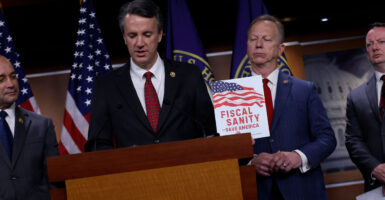Medicare, the huge government health program that serves 66 million senior and disabled citizens, is at a crossroads.
With huge demographic and fiscal challenges straight ahead, there are two dominant approaches at hand.
One focuses on improving and modernizing the program by building on the best features of Medicare’s popular system of competing private health plans, harnessing the benefits of personal choice and market competition. The other focuses on building up the powerful Medicare bureaucracy and doubling down on its complex system of central planning and price controls.
The Medicare trustees reported last year that the trends in Medicare administrative payment and price controls, governing both hospital and physician payment, already threaten seniors’ future access to quality care.
With the enactment of President Joe Biden’s absurdly named Inflation Reduction Act, supplanting private market negotiation with government price-fixing, Americans can expect a slowing of investment in research and development and consequently a reduction in the number of new medications and breakthrough drugs, especially cancer drugs.
The only debate between analysts of the Congressional Budget Office and private sector economists is the severity of the coming shortfalls.
The House Republican Study Committee clearly “gets it” and grasps the urgency of this moment. The proof is its fiscal year 2025 budget proposal, “Fiscal Sanity to Save America.”
The committee’s budget proposal is a refreshing exception to the prevailing Beltway wisdom. Its prescriptions align with what seniors have well demonstrated what they know and like; namely, the advantages of personally chosen and more flexible benefit options that can be delivered through more intense market competition.
In substance, the Republican Study Committee proposal would build on the success of choice and competition that characterizes Medicare Advantage. Today, an estimated 52% of all Medicare beneficiaries are enrolled in Medicare Advantage, the robust system of competing private health plans that is the alternative to traditional Medicare.
Enrollment in these private health plans is growing a lot faster than ever predicted. For example, as recently as 2022, the Medicare trustees estimated that private plan enrollment would not top 52% until 2030.
Under the budget proposal, traditional Medicare (aka the “Fed Plan”) would be retained as an option for Medicare beneficiaries. However, it would be improved by consolidating Parts A, B, and D, like most Medicare Advantage plans, into one comprehensive benefits package.
This “Fed Plan” would compete directly on a level playing field with today’s Medicare Advantage plans for seniors’ enrollment.
Structurally, today’s Medicare funding streams would be merged into a single trust fund and financed, as it is today, by a combination of payroll taxes, premiums, and federal subsidies from general tax revenues.
Every senior would be able to choose the kind of health plan he or she wants, whether traditional Medicare or a private Medicare Advantage plan, and the government would make a defined contribution (“premium support”) in a fixed amount to cover the cost of the chosen coverage, as it does today in Medicare Advantage and for Medicare drug coverage.
Under the Republican Study Committee proposal, the defined government contribution (“premium support”) to health plans on behalf of enrollees would be the product of market-based competitive bidding to offer the standard Parts A, B, and D benefits.
Enrollees would have the option of choosing a health plan that is “premium free,” as they do today in Medicare Advantage, meaning that they would not have to pay any additional premium amount above the monthly standard Part B premium.
The Republican Study Committee budget proposal does not dictate the payment formula to be used for setting the government contribution or plan payment, but does suggests two options: The first is that the government payment to health plans could be based on the “average bid” among the plans, which is the method used today for the popular and successful Federal Employees Health Benefits Program, which covers more than 8 million federal workers, retirees, and their families.
A second option is to base payment on the bid of the “second-lowest price” health plan in a region. That’s the method used today to establish plan payment under the Affordable Care Act for the “Obamacare” plans in the nation’s health insurance exchanges.
The House Republicans’ proposal directs the Centers of Medicare and Medicaid Services to establish a “short term” demonstration to test and determine which payment formula would be best and “generates the most value in terms of health outcomes and cost effectiveness.”
The proposal is a giant step in the right direction. It promises to secure both beneficiary and budget savings, as the previous Congressional Budget Office modeling of a broadly similar “premium support” proposal has already indicated.
More recently, former CBO Director Douglas Holtz-Eakin, in an essay in “Modernizing Medicare: Harnessing the Power of Consumer Choice and Market Competition” (Johns Hopkins University Press, 2023), updated savings estimates based on the CBO budget baselines. Assuming a government payment formula based on the “second-lowest price” health plan, Holtz-Eakin estimates that such a comprehensive competitive system could save an estimated $2.2 trillion over 10 years, including $333 billion in savings for Medicare beneficiaries.
Aside from transforming the financing of the Medicare program, the Republican Study Committee’s budget proposal also makes other long-overdue structural changes to other parts of the Medicare program.
Two are particularly noteworthy.
First, the proposal addresses the costly imbalance between Medicare payment for services in a hospital and payment for those same services in a clinic or a doctor’s office. Today, Medicare payment is higher for services delivered in a hospital.
Often called “site neutrality” payment, the proposal would pay medical providers the same, whether the services are delivered in a hospital, clinic, or even a doctor’s office.
This change, long endorsed by The Heritage Foundation and others, would level the playing field of competition between hospitals and non-hospital clinics and facilities and would eliminate the incentive for hospitals to buy independent medical practices to secure higher profits. It would also intensify competition and secure big program savings. (The Daily Signal is the news outlet of The Heritage Foundation.)
The Republican Study Committee reports that this one change alone would yield $202 billion in savings over the next 10 years. Because Medicare is America’s biggest health care payer, accounting for 21% of our spending, this change would also have a positive spillover effect in the private health care markets. It could stimulate competition where it is sorely lacking and help revitalize independent private medical practices.
Second, the proposal would free the Medicare program from paying for the costs of graduate medical education. Medicare today is the largest financier of graduate medical education, helping to pay the direct and indirect costs of hospital residents. The committee’s proposal would remove graduate medical education payment from the Medicare trust funds and create a new and separate trust fund to help offset those costs, as recommended by The Heritage Foundation and others. This committee proposal would save Medicare an estimated $16 billion a year.
As is common with such budget proposals, the Republican Study Committee’s plan is only a broad outline of Medicare reforms. The details must still be worked out legislatively, but it is most certainly headed in the right direction.
By contrast, their Democratic colleagues have a completely different approach. Their agenda is set forth in black-and-white text. As noted, they passed the Inflation Reduction Act that would, for the first time, import a government price-fixing scheme into the Medicare drug program.
In addition, rather than shoring up Medicare for seniors, the Biden administration has already announced a payment reduction for health plans in the Medicare Advantage program. Moreover, the majority of House Democrats have co-sponsored so-called Medicare for All legislation that would literally repeal the existing Medicare program and destroy Medicare Advantage.
Their bill would abolish everyone’s right to any alternative to government coverage, impose massive tax increases on the middle class, and substitute bureaucratic central planning and price controls for personal choice and market competition.
In short, ordinary senior citizens, voting with their feet, are already way ahead of official Washington. Based on the mounting evidence, it’s not hard to see why. Medicare Advantage plans are affordable, offer a richer set of benefits, score very well on most quality metrics, and guarantee protection against the financial devastation of catastrophic illness.
While Medicare Advantage has flaws—chiefly an unnecessarily costly formula for paying health plans—its key features of consumer choice and competition provide a great foundation for comprehensive Medicare reform.




























